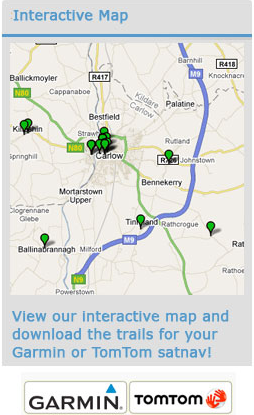All Sites
Carlow Cathedral
Carlow – Ceatharlach
Carlow Town, the county capital is strategically positioned at the meeting point of the Rivers Barrow and Burrin. This trail enjoys a strong association with St. Patrick, Ireland’s national saint. Relax and enjoy discovering its rich Christian heritage in settings which radiate peace and spirituality.
1. Carlow Cathedral was built between 1828-33 to [...]
Carlow College
2. Carlow College, otherwise known as St. Patrick’s College is Ireland’s oldest third-level Catholic College. It was founded in 1782 and opened in October 1793 following the relaxation of the Penal laws which restricted Catholic education. Dr. James Keeffe, Bishop of Kildare and Leighlin along with his successor, Bishop Daniel Delany, were the driving forces [...]
Carlow’s churches
3-7. Carlow’s churches
With the building of the Anglo-Norman castle in the first decades of the thirteenth century, Carlow grew into an important medieval town and its parish church may have stood on the site now occupied by St. Mary’s Church of Ireland. The present building dates from the early eighteenth century although the spire was [...]
Carlow’s convents
8-10. Carlow’s convents
A leisurely stroll through the streets of Carlow Town reveals a rich ecclesiastical history. This stretches all the way back to the sixth century when St. Croine Bheag, a female recluse, was associated with the area now known as Templecroney near the Haymarket. Tradition holds that it was she who advised St. Columbanus [...]
Killeshin – Cill Uisean – the church of Uisean
11. Killeshin Romanesque Doorway
St. Patrick introduced Christianity into Ireland in the fifth century and heralded a golden age of Christianity which produced a rich heritage of architecture and ecclesiastical art. Killeshin was the site of an early monastic settlement associated with saints Diarmait and Comgán. St. Mugen who was abbot here in the sixth century [...]
Ballinabranagh – Baile na mBreatnach
The early nineteenth-century 13. St. Fintan’s Catholic Church is a fine example of a double-height single-cell ‘barn-style’ space lit by round-headed windows. The gables are adorned by squat columnar granite pinnacles. The fanlit entrance doorway, set in a granite architrave, echoes the contemporary taste in domestic architecture. Features of note include the marble altar which [...]
Tinryland – Tigh an Raoilinn
14. St. Joseph’s Catholic Church was originally built in 1819 by Fr. Matthew Malone and consecrated by James Doyle, then Bishop-Elect of the diocese of Kildare and Leighlin. It was built on the site of a mud-walled chapel. The three stone fonts in the porch came from this chapel while an old font from Linkardstown [...]
Kellistown – Cill Asna – St. Osnadh’s church
Ruined nineteenth-century 15. Church of Ireland church with remains of medieval church behind. Situated on an elevated site overlooking rich rural countryside, this ruinous First Fruits church dates from 1810. It has an austere simplicity and comprises a three-bay nave with lime rendered walls and pointed windows, a porch on the north side and a [...]
Tullow – An Tulach – The Hill
16-21.
With its picturesque location on the banks of the River Slaney, Tullow is a lovely example of a traditional Irish Town and is known locally as the granite town because of the fine stone used in its walls and public buildings. Tullow was a location of ecclesiastical importance from at least the late fifth century when a [...]
Clonmore – Cluain Mhór – Great Meadow
22.
Clonmore is one of Carlow’s most important early Christian sites with a wealth of history for visitors to discover. The present road cuts through the monastery founded by St. Maedóc around 600 A.D. No traces of the monastic buildings remain but the importance of the site is attested by the presence of two large crosses, [...]
